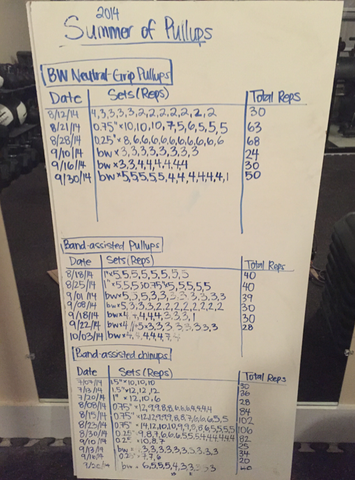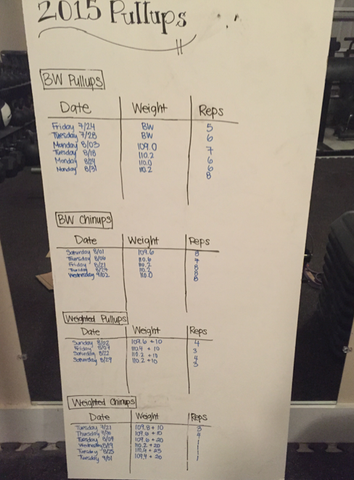How to Get Your First Chin-up
If you ask me what I think is the most badass exercise that a woman can do, I’ll tell you that it’s the chin-up, without hesitation.
Why? Because they are, in my opinion, the perfect intersection of lean, athletic, and strong.
Not all ladies can do them. And those that can have worked for months and months to get their first rep. They likely put in a good deal of dedicated time and effort into building up their upper body strength so they could clear their chins over the bar.
For those ladies who can into a gym on any random day and bust out a beautiful chin-up, #respect.
Can Women Do Chin-Ups?
Some men will tell you no. Hell, even some women will tell you that it’s not possible.
If anyone remembers this New York Times article from a few years back, the author (a female, at that!) very misleadingly writes about why women supposedly can’t do pull-ups. In this piece, Parker-Pope discusses a University of Dayton study that recruited 17 college-aged women and put them through a three-month training regimen that would supposedly help them perform a pull-up. Participants performed biceps-strengthening exercises and modified pull-up variations three days a week, but by the end of the program, only four of the 17 women could perform a single bodyweight pull-up. Therefore, the author concludes, despite the fact that four women did get a pull-up, she makes the sweeping generalization that women cannot do pull-ups. Period!
Um, what? Did she not just say that four women… could… nevermind.
There is a big, big difference between “can’t,” as in, physically incapable of doing something, and “have a harder time achieving,” which implies that with concerted effort, some specific task can be done.
So yes, actually, women can do pull-ups, and they can actually do them quite well.
I’ve asked some of my #eatliftthrive teammates to contribute some videos of themselves knocking out chin-ups, pull-ups, and variations thereof to show you exactly what women are capable of. Look at all these women failing miserably at pull-ups (please note the heavy sarcasm here).
I also have a video of my former client Shelley Cook (who, by the way, is a mother of three and recently killed it on the figure stage) doing weighted chin-ups here (10lbs x 5):
And finally, to show that I do indeed walk the walk, here’s a video of me doing 11 neutral-grip pull-ups last year:
as well as weighted pull-ups (10lbs x3):
Yes, it may be harder for us to accomplish them, but that’s because women tend to have poorer relative upper body strength as compared to men (Miller et al., 1993). As well, women tend to carry slightly more mass in their lower bodies overall.
All of this to say that while it’s possible for women to rock chin-ups for multiple reps, we do face more of an uphill battle than men do, and it typically takes us far longer to get that first bodyweight rep.
(I will note here that there are obviously outliers who indeed are not capable of performing a single chin-up no matter how hard they try, but these individuals typically have a combination of: 1) poor genetics in terms of their ability to pack on muscle mass and strength; 2) poor leverages in the upper body musculature for performing the pull-up; and 3) poor anthropometry in terms of ratios of upper body to lower body mass.)
What’s the Difference Between Pull-Ups and Chin-Ups?
Fair question.
The pull-up involves a pronated (overhand) grip, whereas with the chinup, you used a supinated (underhand) grip. Then there’s also the neutral-grip pull-up, in which your palms are facing in toward each other.
A 2010 study conducted by Youdas et al. in the Journal of Strength and Conditinoing Research found that pullups and chinups both activated the latissimus dorsi, biceps brachii, infraspinatus, lower trapezius, and pectoralis major, erector spinae, and external oblique. In other words, pullups and chinups involve a whole lot of upper body muscles (plus the abs!), making them two of the best upper body compound movements out there.
The chin-up activates the pectoralis major and biceps brachii to a greater extent, though, while pull-ups involve greater activation of the lower trapezius. This may in part explain why pull-ups tend to be harder to do.
For these reasons, we’re going to tackle the chinup first.
What Does a Proper Chin-Up Look Like?
Here are a few key points to keep in mind with a chin-up:
A proper rep involves full range of motion (ROM). That means you start from a dead hang and work your way up, and then come all the way back down. Some people may say that it’s unsafe to go to full lockout at the bottom of each rep as it’s bad for the joints, but I see no problem with doing so as long as it’s pain-free. I’d rather see pain-free full ROM rather than wimpy half-reps (which, by the way, don’t count in my book unless there’s some medical rationale).
Your chin must clear the bar (in other words, you must get all the way up to the rep) in order for the rep to count. Depending on who you ask, people may even say that your sternum or touch has to touch the bar. I’m okay with this recommendation as long as it’s clear that you’ve actually made it all the way up to the top.
You want to maintain tension throughout all reps, even at the bottom when you’re at a dead hang.
Limit the body English. A kipping chin-up is a kipping chin-up, not an actual chin-up. No flailing, no partial reps, no funny business. While there will almost always be some compensatory movement in a chin-up, try to keep it to a minimum.
What Can I Do to Get My First Chin-Up?
Eccentric Chin-Up
I did a lot of these before I could get my first real bodyweight chin-up. What this involves is essentially getting yourself up to the top of a rep (typically via jumping) and then slowly lowering yourself back down. I like to do at least a 3-second count with these, although I’ve been known to extend them for even longer, as you can see below.
If you’re unable to perform eccentric chin-ups, there are still other options for you.
Band-Assisted Chin-Up
This was my to-go movement last summer when I was trying to increase my reps. I really like this variation because it provides progressively less resistance as you pull yourself up to the bar. The one thing I will say about this is that yes, it necessarily provides the most tension at the bottom where individuals typically tend to struggle the most. With that said, I still think it’s a really great way to practice proper form, increase confidence, and get your reps in.
As well, as you gain strength, you can move from having the band looped around your feet to having the band looped around your knee, and then work your way down to using thinner and thinner bands.
Iso Hold Chin-Up
This involves getting your chin over the bar in whatever manner possible (either by jumping, using a bar, of having a gym buddy help you up) and then holding that top position for a few seconds. This can help if you are someone who struggles with the top portion of a rep.
Try to hold for a 5-second count before lowing yourself back down.
Chest-Supported Row and Inverted Row
These are exercises that will help improve your pulling strength. I think these are a great option for those of you who don’t yet have the physical strength to perform eccentric chin-ups (i.e. you’re essentially dropping straight down without being able to resist the force of gravity) or if you’re not quite ready for band-assisted chin-ups yet. In this case, I would recommend building up your strength via chest-supported rows and inverted rows.
With chest-supported rows, use a variety of rep ranges (I would recommend six or more), and for inverted rows, I would say that once you can do 15 reps at a given height, advance the movement by adjusting your body such that you are more horizontal to the floor. Eventually, you can move onto the feet-elevated variation. You can do them with a TRX or a barbell in a squat rack.
Pull Into a Row
This tip comes from Max Shank by way of Bret Contreras’s blog. Before this, my recommendation for getting stronger at the bottom of the rep was to simply get stronger overall.
In the video below, Max shows you how to put your shoulders in a better angle to lift yourself up via a pull-up/row hybrid.
Increase Frequency
Now I’m not saying that this method will work for everyone, but some people respond really well to volume and frequency.
You can increase frequency in a number of ways: by doing some chin-up variation everyday (maybe even multiple times throughout the course of a day) or by tossing them into every training session,
For me, when I told my trainer Bret Contreras that I wanted to increase my pull-up strength, he prescribed them to me 4x/week at the beginning of every workout. So right now, I’m doing 1xAMRAP bodyweight pull-ups, 3×1 weighted chin-ups, 1xAMRAP bodyweight chin-ups, and 1xAMRAP weighted pull-ups. Note that this is the protocol specific to me, my needs, and my anthropometry. Last year, when I wasn’t quite as strong, I was incorporating a lot of band-assisted variations and eccentric chin-ups into my routine 3x/week, which is how I achieved the 11 bodyweight neutral-grip pull-ups in the video above.

Here’s a picture of the whiteboard I used to track my progress last year. As you can see, lots of volume!
Lose Bodyfat
Along with increasing strength and flat-out practicing, losing bodyfat will take you a long ways toward your goal of accomplishing your first bodyweight chin-up. This is largely because fat mass doesn’t actually help contribute to the lift at all and really just weighs you down.
The best way to accomplish this, if you ask me, is via dietary intervention. It’s far easier to lose fat by cutting back on your daily caloric intake rather than trying to burn off extra calories from more exercise. Of course, strength training is an important part of the muscle-retention process as well, but that bodyfat is not going to budge if you’re eating Ho Hos all the doo-dah day.

Here’s a basic primer on how to determine your macronutrient numbers, and I’m now also offering a custom one-time macro calculating service that comes with exercise recommendations and access to a Facebook support group
Be Patient
Some women can get their first chin-up within a matter of weeks, while for others, it may take months or even years depending upon their starting point. Don’t let this deter you from your pursuit of badassery.

As well, tracking your progress from week to week can be incredibly helpful in determining whether or not you are indeed moving in the right direction. Above you’ll see my whiteboard that I’ve been using this year to log my numbers over time.
You’ll notice that strength progress is not linear, and that’s completely normal. Don’t get discouraged if you go a handful of weeks with seemingly no gains.
At the end of the day, there are multiple methods that can work. You can improve your grip strength. You can improve your core strength. You can do lat pulldowns. You can use a assisted pull-up machine. You can do high volume, low frequency. You can do low volume, high frequency. You can do high volume and high frequency if your body can handle it.
I’d love nothing more than to see more and more women busting out beautiful chin-ups left and right. Let’s get to chinning!
References
Flanagan, S.P., Vanderburgh, P.M., Borchers, S.G., Kohstall, C.D. (2003). Training college-age women to perform the pull-up exercise. Res Q Exerc Sport. 74(1):52-9.
Miller, A.E., MacDougall, J.D., Tarnopolsky, M.A., & Sale, D.G. (1993). Gender differences in strength and muscle fiber characteristics. Eur J Appl Physiol Occup Pshyiol. 66(30):254-62.
Youdas, J.W., Amundson, C.L., Cicero, K.S., Hahn, J.J., Harezlak, D.T., & Hollman, J.H. (2010). Surface electromyographic activation patterns and elbow joint motion during a pull-up, chin-up, or perfect-pullup rotational exercise. J Strength Cond Res. 24(12):3404-14.




